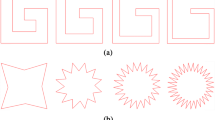Abstract.
The issue of mesh quality for unstructured triangular and tetrahedral meshes is considered. The theoretical background to finite element methods is used to understand the basis of present-day geometrical mesh quality indicators. A survey of more recent research in the development of finite element methods describes work on anisotropic meshing algorithms, and on providing good error estimates that reveal the relationship between the error and both the mesh and the solution gradients. The reality of solving complex three-dimensional problems is that such indicators are presently not available for many problems of interest. A simple tetrahedral mesh quality measure using both geometrical and solution information is described. Some of the issues in mesh quality for unstructured tetrahedral meshes are illustrated by means of two simple examples.
Similar content being viewed by others
Author information
Authors and Affiliations
Rights and permissions
About this article
Cite this article
Berzins, M. Mesh Quality: A Function of Geometry, Error Estimates or Both?. Engineering with Computers 15, 236–247 (1999). https://doi.org/10.1007/s003660050019
Issue Date:
DOI: https://doi.org/10.1007/s003660050019




